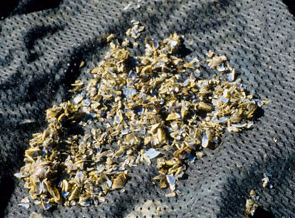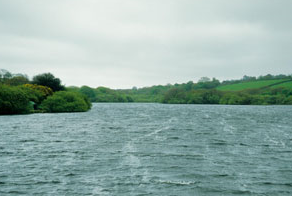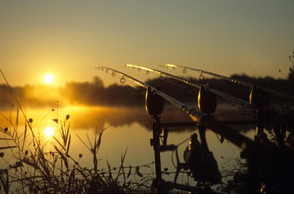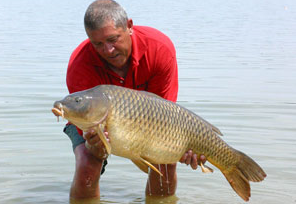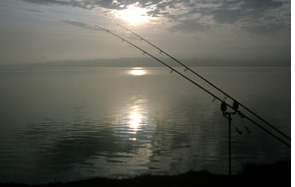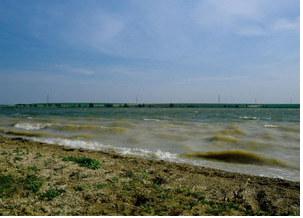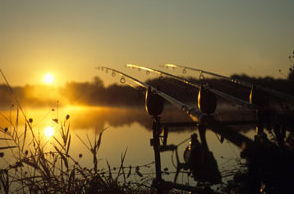There is a lot of talk in the magazines and other instructional; media these days about the importance of “following the wind”, but what does this mean in practice? When experts talk about carp following the wind their reasoning is:
1) That a new wind will encourage the carp to move in the direction that the wind is blowing because it will cause the water to become much more coloured with churned up suspended solids and disturbed food items. In the dirty, food-enriched water the carp should be less cautious than in settled conditions when the water clarity is better and less food is stirred up from among the weed fronds and out off the silt lying on the lakebed. Carp are less aware of the possibility of danger in these turbulent conditions and they feed more confidently and aggressively. In conditions such as these the use of mass and particle baits is a very effective tactic.
2) That extra turbulence from the breaking waves will greatly increase the amount of oxygen in the local area where the water is churned up. Carp get really turned on in this oxygen-rich water and it gives them a real surge of energy. This is because the boosted water increases a carp's metabolic rate, making it feel livelier and more likely to feel like a bite to eat! If it blows really strongly, say gale force or even stronger and the wave effect becomes even more pronounced the undertow created by the pounding waves can stretch back out into the lake by fifty or even sixty yards. Imagine all that dirty, highly charged lake water sitting right in front of you seething with carpy activity and just crying out for your hookbaits to splash down in the middle of all those feeding carp. A secondary and most useful effect is that other life forms also enjoy this enriched turbulence. Mussels, crayfish and snails will themselves feed avidly on the disturbed particles and they in turn are food for the carp.
3) We know that carp are creatures of instinct and thus they will be fully aware of the effect of a strong wind beating on a shallow shoreline. Even if to start with there are no resident carp in the area towards which the wind is blowing, once it picks up in strength or shifts in direction their instinct nudges them to follow the direction of the breeze, for they know what they will find when they get to the lee shore.
The above reasoning is valid and for the most part it holds true, but not always! Yes, there are times when the carp follow the wind and you can catch lots of fish if you are there to greet them. On the other hand I have fished plenty of sessions when I sat there with a full gale blowing straight towards me waiting in vain for fish that never arrive.
So why do carp sometimes ignore the influence of the wind? Indeed, you could be forgiven for thinking that they would be impossible to ignore. One of the most likely explanations is angling pressure. You may think this is a bit far fetched but believe me, I have fished enough pressure waters to know that anglers play a major part in affecting the behaviour of carp, often to the extent that they will defiantly refuse to follow a new or strengthening wind. As carp fishing becomes ever more popular there are signs than on some of the most hard-fished lakes the fish have started to rebel against their instincts and ignore the influence of the wind.
When I joined Savay many of the members told me that the wind had become far less of a determining factor than was the case when the lake first opened to carp angling a decade earlier. Rod Hutchinson was one of the original members of Savay when it first opened in 1980 and anyone who has read Rod’s classic book ‘The Carp Strikes Back’ will know that he set great store in the changing weather conditions at the lake, moving swims with the slightest shift or increase in the wind and staying glued to the weather forecasts whether he was actually fishing at the lake or not.
Savay is a long fairly narrow lake that is often swept by strong winds and in the early days it was true that the fish would definitely move in the direction of the wind, but by the time I joined things had changed. While it was true that some of the fish continued to follow the breeze, they did not do so in the sort of numbers as was the case in the lake’s early days.
I can recall arriving for a session one hot July day. As I always do when I arrive at the lake I had a walk around to see if there were any fish showing. There was a warm summer wind blowing down the lake and it looked very encouraging. Surprisingly there was only one member fishing and he was right down at the far end of the lake where the strong, warm wind was pushing waves against his margin. It looked perfect but he had caught nothing in the three days he’d been in there, nor had he seen a fish.
I walked back up towards the carp park at the opposite end of the lake and stood overlooking a small area of the lake near the bailiff’s island. The wind was blowing strongly over my shoulders and down the lake, passing over an area of shallower water without causing so much as a ripple, but as I stood looking out over the area a carp pushed its head out. I didn’t need any further persuasion and set up on the shallows. Even though the wind continued to blow hard down towards the far end of the lake the Savay carp resolutely refused to follow its influence and I caught two fish within 12 hours of setting up.
I have experienced this phenomenon on many other lakes as well. I have included a photo of one of my favourite UK lakes, College Reservoir, a 40-acre lake in the southwest where I cut my big-water carp fishing teeth in 1982. The southern end is sheltered from the prevailing wind by tall trees and a steep valley. Two large islands lie at the southern end. The lake is strongly affected by the weather and the prevailing wind is a southwesterly. This blows up the lake away from the islands and you could be forgiven for thinking that the carp would follow a big wind towards the northern end of the lake. Strangely however, the majority of them prefer to hang around the sheltered southern end of the lake and only a few fish venture up with the wind.
It took me several abortive trips to learn this! All my instincts cried out to me to get on the wind when it was blowing hard from the south or southwest, and yet my results were invariably disappointing. It was only when I decided to take a risk and stay in a swim at the southern end of the lake during a big southerly gale that I realised that the majority of College’s carp much preferred the safety afforded by the islands in the sheltered southern end of the lake.
Carp that inhabit smaller lakes are less influenced by the strength and direction of the wind and usually the bigger the water the greater the influence of the wind on the lake’s surface. On big lakes of say 50acres or more even a moderate breeze can push up quite big waves whereas on a much smaller water of say a couple of acres the same wind will have hardly any effect at all.
The depth of water can also influence the way in which the wind can affect the lake water, and carp in shallow lakes are more likely to be pushed around on the wind than those that inhabit really deep lakes. One very good carp lake in my area is a flooded limestone quarry. It lies in a steep- sided valley whose slopes are heavily wooded with towering trees. The prevailing southwest wind sweeps down the valley where the steep sides accelerate the breeze so that the lake becomes whipped up quite quickly. Yet in all the years I have fished there I have never known the fish to be influenced by the wind. The reason for this is, I believe, because of the depth of the lake. In places it drops down to over 20m and even the margins are 3-4m deep. It can blow all it likes but those almost vertical sloping sides will cushion any effect the wave action may have. Conversely a shallow slope onto which a fresh onshore wind is blowing is much more likely to attract carp.
Water temperature will also be a major contributing factor, especially in winter when I have found that fish are often reluctant to move on any wind regardless of its direction. In fact, in winter the strength and direction of the wind does not figure in my choice of swim at all as I feel that there are more important factors to take into consideration such as atmospheric pressure and of course water temperature, but that subject is for another time.

